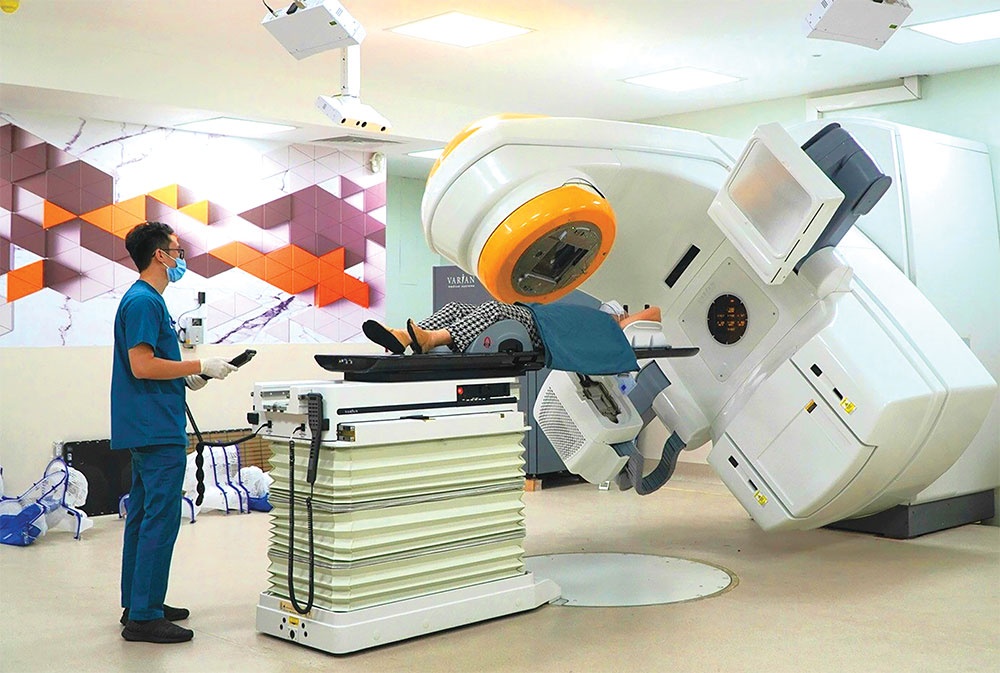Modern policy for private hospitals
Stemming from Resolution No.90/CP in August 1997 on the direction and policy of promoting private engagement in educational, medical, and cultural activities, Vietnam has a proud history of crafting policy on the nation’s health. They include legislation on development of non-public service providers, as well as encouraging private investment in education, vocational training, sports, the environment, and lots more.
 |
| Prof. Dr. Nguyen Van De - chairman of the Vietnam Private Hospital Association |
Over the past decade or two, these policies have been updated and amended in order to strengthen Vietnam’s framework in this area.
These policies have created favourable conditions for localities to organise, apply, implement, and have clear and transparent mechanisms and policies, especially administrative reform in attracting investment for health projects.
More importantly, we have attracted many resources, specifically from businesses and capable investors both at home and abroad, thus contributing to the development of Vietnam’s healthcare on par with the development of the medical field in advanced countries worldwide.
As of 2004, a number of private hospitals with a scale of 30-50 beds were established in the south and north, including Hop Luc General Hospital, creating fresh air for private investment in the medical field. According to statistics from the health sector, as of 2013, the country had 155 private hospitals with a total of more than 9,500 beds. This year, the country is projected to have over 300 private hospitals and 38,000 clinics.
Among them, there are many private hospitals with 1,300 beds and more equipped with modern medical equipment, and increasingly high quality of exam and treatment. In particular, a number of hospitals have invested into chains or other ecosystems, boasting international-standard treatment areas and performing many high-tech services such as vascular intervention, oncology treatment, and organ transplants. These facilities include Vimec International Hospital, Hop Luc General Hospital, Haiphong International General Hospital, Hung Vuong Phu Tho General Hospital, Tam Anh General Hospital, and others.
Major highlights
According to the health sector, the development of private healthcare has contributed to reducing the overload at provincial and central hospitals. Through the construction and development of private medical examination and treatment establishments, competition between state-run hospitals and private ones has emerged, thus changing the thinking and perception of private healthcare, and abolishing the thought that only state healthcare can carry out certain tasks.
Since its establishment, Vietnam’s private healthcare has made great contributions to the development of the health sector. Not only helping ease hospital overload and increasing access to high-quality healthcare, the private sector also makes a huge contribution to the country’s critical and historical events, such as pandemic prevention and control.
However, looking back on the development path after more than 20 years, Vietnam’s private healthcare sector has not yet developed to the right level, and has not brought into full play its resources and potential. The Party and state’s policies and objectives on attracting and mobilising resources from the non-state sector to participate in the public service market have been clearly stated in Resolution No.19-NQ/TW and Resolution No.20-NQ/TW of the Party Central Committee.
The Party’s viewpoint is to mobilise resources and promote the development of private healthcare, contributing to solving the shortcomings and limitations of the existing public health service units. However, the actual implementation of the Party’s directions and the state’s policies has not yet achieved the results as set out in the resolutions.
Many members of the Vietnam Private Hospital Association and the business community said that while the Party’s policies and views are obvious, when promulgating new legislation, there has been anxiety and concern. There remains conflicts among laws, decrees, and circulars, as well as a lack of consistency in legal enforcement among cities and provinces.
For example, there are localities that have agreed with investors to build private hospitals in line with Decree No.69/2008/ND-CP and Decree No.59/2014/ND-CP. However, when it came to compensation and site clearance issues, localities required investors to negotiate with the people for site clearance and land compensation for project implementation in line with the Law on Land.
Meanwhile, according to the aforementioned two decrees, provincial people’s committees take the basis of local budget capacity to make compensation, site clearance, and handover of cleared land for investors to rent to implement projects partaken in by private enterprises; and at the same time support land rental during the land lease period for project implementation.
There are numerous things that need to be amended to create conditions for domestic private and foreign investment in the health sector to contribute to obtaining the targets set by Resolution 19 and Resolution 20:
The specific objectives in Resolution 20, dated October 2017, include the rate of private hospital beds to reach 10 per cent by 2025 and 15 per cent by 2030.
However, at the 15th National Assembly in 2022, the government said that there are only 318 private hospitals in the country and 38,000 private clinics, meeting only 5.16 per cent of the total number of hospital beds. The rate is very low.
In the current period, the development of private healthcare is an inevitable trend and suitable for the economy according to the socialist-oriented market mechanism. However, the facts show that the private healthcare sector in our country has not developed properly with the potential and needs of society.
Therefore, how to encourage and attract businesses to invest in private hospital projects, build a strong private healthcare system, and make more worthy contributions to the development of the health sector is a question being posed to state management agencies.
In order to achieve the set goals, the state must complete the legal regulations on private healthcare funding, and create favourable conditions in the implementation of regulations on investment in the health sector. Especially, there should be a consistent process of formulating policies and incentives on land, taxes, and loans.
There must be simplified procedures, especially removing regulations on bidding and auctioning for private hospital projects, assigning local authorities to be responsible for allocating land, and exempting, reducing, and not collecting land use levies throughout project implementation.
If so, this field will have a competitive edge to attract investment, ease the burden on the state budget, and achieve the goals of social security and healthcare.
 |
| Modern policy for private hospitals, Photo Le Toan |
Future trends
The country’s next health evolution was announced in 2019 and approved in 2020 as the National Digital Transformation Programme to 2025, with vision towards 2030. Digital transformation contributes to building a modern, quality, fair, efficient, and international-standard Vietnamese healthcare system. It supports people in easily accessing health information to use services with high efficiency and to be protected, cared for, and improved continuously for life.
Vietnam’s private healthcare system is no exception to this policy and is actively implementing it in accordance with the roadmap prescribed by the government and the Ministry of Health (MoH).
Up to now, many private medical facilities have actively implemented and invested hundreds of thousands of US dollars in digital transformation for healthcare activities. However, the number of applications is few due to their different nature and scale. The level of funding in technical infrastructure and software for digital transformation is too big, while private healthcare resources are limited.
If state-owned medical facilities are fully funded via the state budget, private healthcare ones have to spend their own money to implement schemes. However, the full calculation of service prices to return to investment in digital transformation has not been clearly guided or regulated.
Even the calculation of the cost of printing film as a replacement for conventional printing has not yet been regulated and promulgated by the MoH. This is causing great difficulties and creating anxiety for private medical facilities when deciding to invest in digital technology.
In the inevitable trend of integration and development, with favourable policies and fairer laws on investment, more financiers and businesses will become strongly involved in the medical field. Although this is a difficult and sensitive field, with the potential and advantages of population, there are many investors interested in the sector.
Moreover, in the current context, the state is calling for investors and businesses to join to reduce the burden of public funding pressure in the health sector to develop national infrastructure development.
In the future, more private health facilities will be built, especially for the grassroots network, and private-run ones will gradually replace them. The higher-level hospitals will carry out specialised and high-tech research, develop and implement new domestic and international technical services, and then transfer them to lower levels for implementation.
The facts show that many private health facilities have boldly invested in modern facilities and equipment for treatment activities.
For example, Hop Luc General Hospital has invested in a cancer treatment centre of international standards with the most modern medical equipment available today; and Hung Vuong Gia Lai Hospital and Philips Group signed a strategic cooperation contract to provide advanced digital medical solutions.
Private healthcare must open the door to learn and welcome more advanced activities, partly to encourage Vietnamese patients to remain in this country for medical treatment.
Over past years, our members have worked and signed many cooperation agreements with foreign partners, while building and developing partnership with businesses and investors in Asia-Pacific to strengthen supply chains and create a sustainable digital health economy.
In the future, we will continue to boost international cooperation, strengthen investment coordination and training, and exchange of experience between private medical facilities and foreign-funded facilities as a way to contribute to the protection of Vietnamese health.
 | Hospitals look for way out over cost traps in tender rules Hospitals and medical equipment suppliers are looking to get back on the right track with the Ministry of Health hoping to solve price issues when it comes to tender rules of medical supplies. |
 | Hospitals bemoan autonomy trial flop After a trial period of two years, state-owned central hospitals are seeking to cease comprehensive autonomy because of financial challenges and legal complications, urging more legal changes ahead. |
 | Hospitals benefiting from double revision While the shortfall of medical devices at hospitals has eased since new rules were introduced in March, more improvements are required to further facilitate the healthcare sector. |
What the stars mean:
★ Poor ★ ★ Promising ★★★ Good ★★★★ Very good ★★★★★ Exceptional
Themes: Healthcare Platform
- Takeda Vietnam awarded for ongoing support of Vietnam’s sustainability efforts
- Self-care signals shift towards sustainable healthcare
- DKSH to acquire Vietnamese healthcare distributor Biomedic
- Two national hospitals expand capacity with new facilities
- Vietnam moves to enhance disease prevention, equity, and sustainability
Related Contents
Latest News
More News
- Main drivers for Vietnam’s digital economy future (December 03, 2025 | 11:35)
- Pivotal stage of growth paves way for rise in M&As (December 03, 2025 | 10:00)
- Positive projections for M&A interest from Thailand (December 03, 2025 | 09:40)
- Manifesting the first line of defence in cybersecurity (December 03, 2025 | 09:00)
- The transformational role AI can play in accounting arena (December 03, 2025 | 08:00)
- Unlocking 5G-AI potential in Singapore (December 03, 2025 | 08:00)
- Data-driven strategies vital for a fast-evolving nation (December 02, 2025 | 09:41)
- Policy to practice: how Vietnam can lead the region (November 26, 2025 | 16:03)
- Mobilising private capital at scale vital for climate battle (November 26, 2025 | 15:36)
- VILAF and Yoon & Yang launch Vietnam - Korea Practice Unit (November 26, 2025 | 15:16)

 Tag:
Tag:



















 Mobile Version
Mobile Version